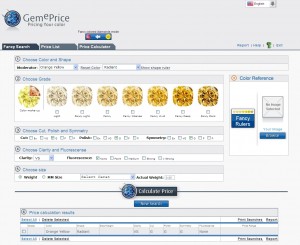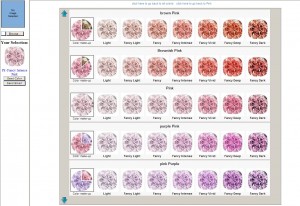©2011 by Richard W. Wise, G.G.
First off, Gem-e-Price is the first grading/pricing software that I have evaluated and working with it was a lot of fun. With the recent addition of colored diamonds, Gem-e-Price is now able to offer a price structure for just about all species and varieties of colored gemstones.
Gem-e-price offers three ways to approach the evaluation/pricing process. I say evaluation because, although gem-e-price is sold as pricing software, the ability to select quality is a necessary precondition for determining price.
Ease of Use:
The software is easy to use. First you are presented with a fairly clean screen with buttons and drop boxes. There are three tabs; Fancy Search, Price List and Price Calculator. The default screen, Fancy Search allows you to select a gem variety, size, shape, weight, clarity, treatment.

Gem-e-price Home screen showing range of colors in yellow diamond.
Unfortunately it didn’t take long for the first bug to appear. Once you select “color” (primary hue) and “modifier” (secondary hue) and move on to shape, you quickly realize that though you can select your shape from a graphic series, only two shapes will actually appear in the gallery, select round or square cushion, choose any other shape and square cushion is shown.
The images, which in the colored diamonds section covers the basic grades, fancy through fancy dark, are not pictures of actual gemstones or photographic images at all, they are graphic representations. When I first saw these during the introduction of gem-e-price for colored gems, I referred to them as grading by cartoon. However, one function of the software helps overcome this lack of veracity to some degree. Once the color has been selected, say yellow, the “Fancy Ruler” button to the right will take you to a screen with a spectrum representing all colors, from there a “Select Color” button in the center of the screen takes you to a new screen with all permutations of the given color (hue): brownish yellow, brown yellow, orangy yellow and so forth. You get a good relative overview of what the graphic range is supposed to represent and is useful for honing in on the appropriate nuance of color.

Gem-e-price screen showing range of primary and secondary hues in pink diamonds.
It also provides you with a more or less universally accepted color descriptive shorthand, e.g. VpB (vivid purplish blue). I should add that you are able to upload, at the home screen, an actual image of the diamond that you wish to compare and that image follows you from screen to screen.
Nomenclature Issues:
Is the pricing accurate? As Shakespeare said, “aye, there’s the rub.” The answer is yes, no and sometimes. I compared the Gem-e-price with a couple of my own diamonds, then called colored diamond expert Stephen Hofer author of Collecting and Classifying Coloured Diamonds and compared various price lists, pink, gray and blue diamonds generated by the Gem-e-price software. The prices made no sense at all until in a conversation with Gem-e-price developer, Menahem Svedermich, he revealed that the price is pegged fairly low. This will require a bit of explanation.
The point I make in my book, Secrets Of the Gem Trade, is that all fancy vivid diamonds are not created equal. GIA’s colorless diamond grading system has 24 grades, the GIA colored diamond grading terminology has only between 5-7 depending upon the hue. These are fancy light, fancy, fancy intense, fancy vivid, fancy deep and fancy dark. In the vivid category, for example there can be high, medium and low vivids depending upon the saturation/tone of the hue. Gem-e-price assumes a 1-5 saturation grid at each level and pegs its price to level 2. Why not the median? Good question! Well, one week later, Gem-e-price has been updated, it now sports three price levels for each color grade, Regular, Fine and Extra-fine categories and these have helped to better define price levels.
Pricing Accuracy:
With Hofer’s help I took a look at a one carat Fany Intense Pink diamond( FIP). A two thousand dollar spread, in pink diamonds, hardly worth mentioning, the price was spot on. I then went to a 0.70 FVY-O from my own inventory. This is a problem stone, The GIA grading report calls it Y-O, to me its a orangy yellow (oY). So, I tried it both ways. The Yellow-Orange price was way out of the box, the Orangy-Yellow was pretty close to my actual cost. Next I tried a 1.75 Fancy Intense Blue IF which Hofer described as a top stone. The Gem-e-price was between under Hofer’s price by between 100-200,000 per carat—sounds like a lot but we are talking blue diamonds here so it is fair to say that Gem-e-price is in the ballpark. I did some further work, switching over to colored gemstones I priced out emerald, ruby and sapphire. The emerald and sapphire prices came out in the zone, the ruby price, we are talking super-unheated-gem in one carat sizes came out very high. I asked Antoinette Matlins author of the second best book on colored gemstones—opps there goes my Bonanno award—she checked my price and reported results that were similar to mine.
Overall Evaluation:
Overall I like it. Is it perfect, no! It is designed for professionals, in the hands of someone without a wealth of experience it could be a potential disaster, but then what isn’t? Gem-e-price is a useful tool, its got a few bugs, but it is getting better, Svedermich and his team made adjustments as I worked and will, I am sure, continue to improve the product. I like the price grids! A subscription with monthly updates is $300.00 per year and, in my opinion, well worth the price.


